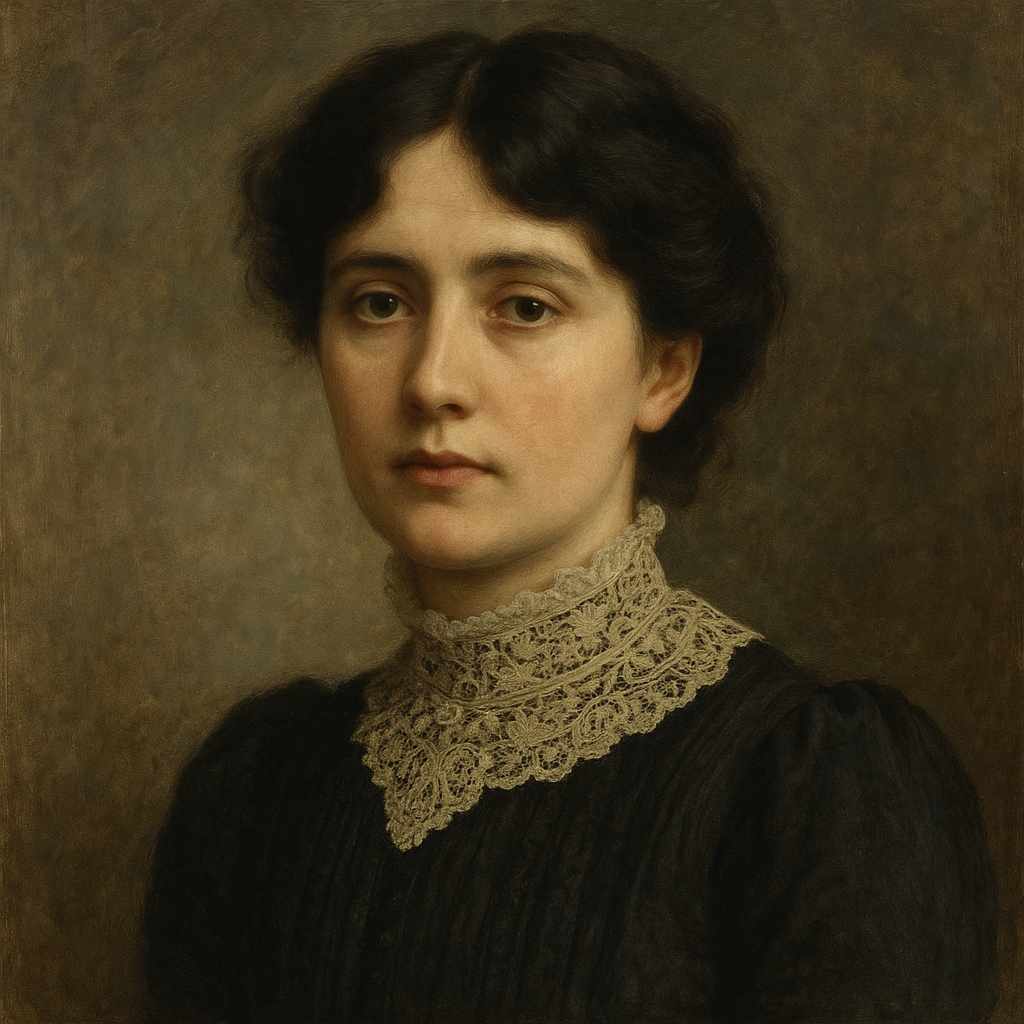An Olive Leaf
Nora Hopper Chesson
1871 to 1906

Want to track your favorites? Reopen or create a unique username. No personal details are required!
I am no rose kissed scarlet by the sun,
Nor pale love-in-a-mist;
No violet that her purple web has spun,
Dreaming of amethyst;
I am no hair-fern, beautiful and brief,
But pale and wan I grow, an olive leaf.
Pale am I, scentless, grayish-green of leaf;
But pluck me — lay me in a hand where grief
Has set her sigil in the hollow palm,
Has set her sigil plain as spring has sealed
The iris of all flowers in the field
To be her herald when the windflowers yield
To crowns-imperial and the spreading balm.
Set me, I say, in this one graven palm,
And I shall change in all my fibres, — know
All beauty to whose heights I dare to grow.
My green shall deepen to an emerald glow,
Redden to ruby, blush into a rose,
Yea, change and grow as passionately sweet
As does syringa, dying with the beat
Of the wild wings of those wild birds that nest
In the warm whiteness of a woman's breast.
So shall I breathe, burn, bloom, and wither so
Held in that hand — for whose love have I grown
Here on my branch, a gray-green leaf alone;
To height of heart's desire reach up, and go
Content, having known the best that I could know.
Nora Hopper Chesson's An Olive Leaf
Nora Hopper Chesson’s An Olive Leaf is a poem of quiet yet profound transformation, exploring themes of self-perception, love, and transcendence through the metaphor of an unassuming leaf. Unlike the vibrant flowers it contrasts itself against—the rose, the violet, the fern—the olive leaf is pale, scentless, and seemingly insignificant. Yet, through an act of love, it undergoes a metamorphosis, achieving a beauty and intensity it could never have realized alone. This essay will examine the poem’s historical and cultural context, its rich literary devices, its central themes, and its emotional resonance, demonstrating how Chesson crafts a meditation on the transformative power of love and belonging.
Historical and Cultural Context
Nora Hopper Chesson (1871–1906) was an Irish poet and writer associated with the Celtic Revival, a movement that sought to reclaim and celebrate Irish cultural identity through literature, folklore, and art. Though less remembered today than contemporaries like W.B. Yeats or Lady Gregory, her work often engaged with themes of myth, longing, and transformation—elements evident in An Olive Leaf.
The olive tree itself carries deep symbolic weight across cultures. In classical antiquity, it was sacred to Athena, emblematic of wisdom and peace. In Christian tradition, the olive branch signifies reconciliation, as seen in the story of Noah’s Ark. Chesson’s choice of the olive leaf, rather than a showier flower, suggests a humility that is nonetheless capable of profound significance when touched by love. The poem’s emphasis on transformation through another’s touch may also reflect the broader Romantic and Victorian preoccupation with love as a transcendent force—seen in works by Elizabeth Barrett Browning or Dante Gabriel Rossetti, where love elevates the mundane into the sublime.
Literary Devices and Imagery
Chesson employs a series of striking contrasts to establish the olive leaf’s initial sense of inadequacy. The opening lines reject the conventional symbols of beauty:
I am no rose kissed scarlet by the sun,
Nor pale love-in-a-mist;
No violet that her purple web has spun,
Dreaming of amethyst;
The rose, violet, and love-in-a-mist (a delicate blue flower) are all traditionally associated with romance and aesthetic appeal. By distancing the olive leaf from these, Chesson underscores its plainness—yet this very plainness becomes the foundation for its later metamorphosis.
The poem’s central conceit is the transformative power of touch, specifically the touch of a grieving hand. The leaf’s potential is unlocked only when placed in a palm marked by sorrow:
But pluck me — lay me in a hand where grief
Has set her sigil in the hollow palm,
The word sigil—a magical or symbolic mark—suggests that grief has inscribed itself permanently, much like spring imprints its essence upon flowers. This imagery implies that suffering is not merely a wound but a form of preparation, making the hand a vessel capable of eliciting beauty from the seemingly mundane.
The olive leaf’s transformation is rendered in lush, almost alchemical language:
My green shall deepen to an emerald glow,
Redden to ruby, blush into a rose,
The progression from green to red mirrors the intensification of emotion, while the simile of the syringa (a fragrant flower) dying under the wings of birds nesting in a woman’s breast evokes both ecstasy and mortality. The poem suggests that love’s touch does not merely beautify but animates, allowing the leaf to experience life in its fullest, most passionate form before its inevitable withering.
Themes: Love, Transformation, and Ephemerality
At its core, An Olive Leaf is a meditation on the idea that true beauty and fulfillment are relational—they emerge not in isolation but through connection. The leaf’s initial existence is one of quiet resignation:
Here on my branch, a gray-green leaf alone;
Yet, when placed in the grieving hand, it undergoes a radical change, not just in color but in essence. This speaks to the Romantic belief that love—particularly love intertwined with suffering—has the power to reveal hidden depths in both the lover and the beloved.
The poem also grapples with ephemerality. The leaf’s transformation is fleeting, culminating in its eventual withering. Yet, far from lamenting this, the speaker embraces it:
Content, having known the best that I could know.
This echoes the carpe diem tradition, where the intensity of a moment justifies its transience. The leaf’s brief, radiant life in the lover’s hand is worth more than an eternity of unnoticed existence on the branch.
Comparative and Philosophical Perspectives
Chesson’s poem resonates with Keats’ Ode on a Grecian Urn, where beauty and truth are intertwined in moments of arrested motion. Like Keats’ figures frozen in ecstasy, the olive leaf achieves its highest state in a single, transformative encounter. There are also parallels to the myth of Daphne, who transforms into a laurel tree to escape Apollo—except here, the transformation is not an escape but an embrace, a willing sublimation into something greater.
Philosophically, the poem aligns with existential notions of meaning being derived from relationships rather than inherent qualities. The olive leaf, like Sartre’s existential hero, defines itself through action—in this case, the act of being held, of burning and blooming in another’s grasp.
Emotional Impact and Conclusion
An Olive Leaf is a poem of quiet power, its emotional force lying in its understated yet profound assertion that love—even love touched by sorrow—can transfigure the ordinary into the extraordinary. The olive leaf’s journey from insignificance to radiance is deeply moving because it speaks to a universal human desire: to be seen, to be cherished, and to find meaning in connection.
Chesson’s language, rich in sensory and symbolic detail, elevates the poem beyond mere metaphor into a lyrical meditation on the nature of fulfillment. The olive leaf’s acceptance of its fate—its willingness to wither after having burned so brightly—suggests that the highest form of beauty is not permanence but the full, passionate engagement with the moment.
In the end, An Olive Leaf is a testament to the transformative power of love, a reminder that even the plainest among us can, in the right hands, become extraordinary. It is a poem that lingers, like the scent of a flower long after it has faded, leaving the reader with a quiet, aching wonder.
This text was generated by AI and is for reference only. Learn more
Want to join the discussion? Reopen or create a unique username to comment. No personal details required!



Comments
No comments yet. Be the first to comment!